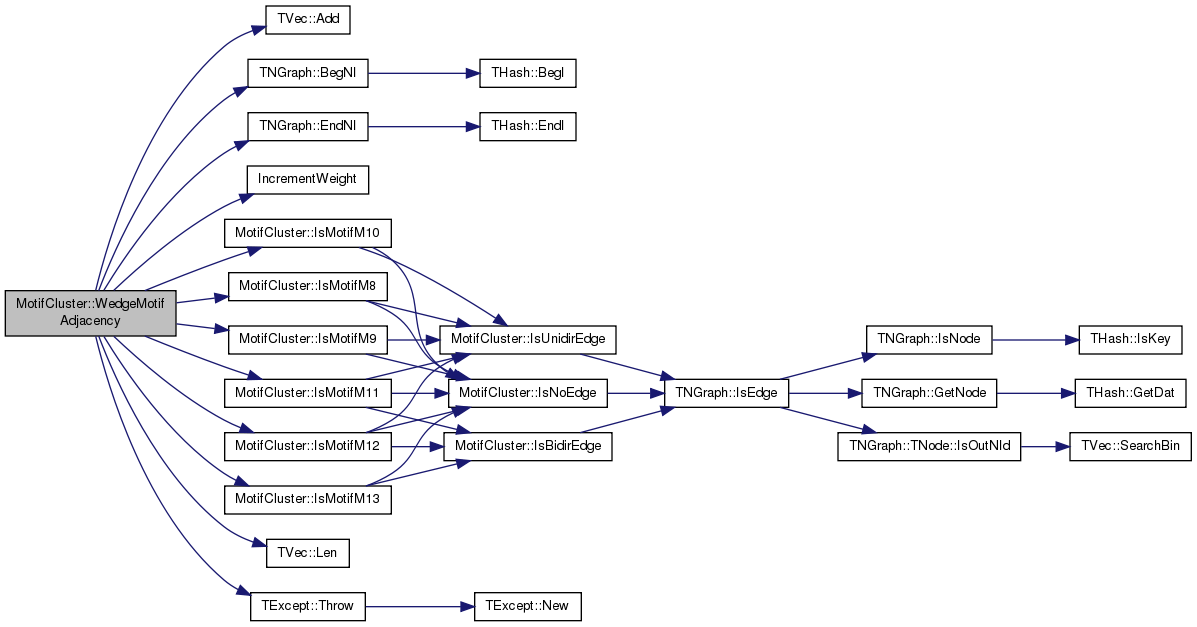|
SNAP Library 6.0, Developer Reference
2020-12-09 16:24:20
SNAP, a general purpose, high performance system for analysis and manipulation of large networks
|
|
SNAP Library 6.0, Developer Reference
2020-12-09 16:24:20
SNAP, a general purpose, high performance system for analysis and manipulation of large networks
|
#include <motifcluster.h>
Static Public Member Functions | |
| static void | GetMotifCluster (PNGraph graph, MotifType motif, TSweepCut &sweepcut, double tol=kDefaultTol, int maxiter=kMaxIter) |
| static void | GetMotifCluster (PUNGraph graph, MotifType motif, TSweepCut &sweepcut, double tol=kDefaultTol, int maxiter=kMaxIter) |
| static void | MotifAdjacency (PNGraph graph, MotifType motif, WeightVH &weights) |
| static void | MotifAdjacency (PUNGraph graph, MotifType motif, WeightVH &weights) |
| static void | SpectralCut (const WeightVH &weights, TSweepCut &sweepcut, double tol=kDefaultTol, int maxiter=kMaxIter) |
| static double | NFiedlerVector (const TSparseColMatrix &W, TFltV &fvec, double tol=kDefaultTol, int maxiter=kMaxIter) |
| static MotifType | ParseMotifType (const TStr &motif) |
| static bool | IsMotifM1 (PNGraph graph, int u, int v, int w) |
| static bool | IsMotifM2 (PNGraph graph, int u, int v, int w) |
| static bool | IsMotifM3 (PNGraph graph, int u, int v, int w) |
| static bool | IsMotifM4 (PNGraph graph, int u, int v, int w) |
| static bool | IsMotifM5 (PNGraph graph, int u, int v, int w) |
| static bool | IsMotifM6 (PNGraph graph, int u, int v, int w) |
| static bool | IsMotifM7 (PNGraph graph, int u, int v, int w) |
| static bool | IsMotifM8 (PNGraph graph, int center, int v, int w) |
| static bool | IsMotifM9 (PNGraph graph, int center, int v, int w) |
| static bool | IsMotifM10 (PNGraph graph, int center, int v, int w) |
| static bool | IsMotifM11 (PNGraph graph, int center, int v, int w) |
| static bool | IsMotifM12 (PNGraph graph, int center, int v, int w) |
| static bool | IsMotifM13 (PNGraph graph, int center, int v, int w) |
| static bool | IsUnidirEdge (PNGraph graph, int u, int v) |
| static bool | IsBidirEdge (PNGraph graph, int u, int v) |
| static bool | IsNoEdge (PNGraph graph, int u, int v) |
| static void | DegreeOrdering (PNGraph graph, TIntV &order) |
Static Private Member Functions | |
| static void | EdgeMotifAdjacency (PNGraph graph, WeightVH &weights) |
| static void | EdgeMotifAdjacency (PUNGraph graph, WeightVH &weights) |
| static void | TriangleMotifAdjacency (PNGraph graph, MotifType motif, WeightVH &weights) |
| static void | WedgeMotifAdjacency (PNGraph graph, MotifType motif, WeightVH &weights) |
| static void | BifanMotifAdjacency (PNGraph graph, WeightVH &weights) |
| static void | SemicliqueMotifAdjacency (PUNGraph graph, WeightVH &weights) |
| static void | CliqueMotifAdjacency (PUNGraph graph, int clique_size, WeightVH &weights) |
Definition at line 56 of file motifcluster.h.
Definition at line 341 of file motifcluster.cpp.
References TVec< TVal, TSizeTy >::Add(), THash< TKey, TDat, THashFunc >::BegI(), TNGraph::BegNI(), THash< TKey, TDat, THashFunc >::EndI(), TNGraph::EndNI(), TNGraph::GetNI(), TNGraph::TNodeI::GetOutDeg(), TNGraph::TNodeI::GetOutNId(), IncrementWeight(), IsNoEdge(), IsUnidirEdge(), and TVec< TVal, TSizeTy >::Len().
Referenced by MotifAdjacency().
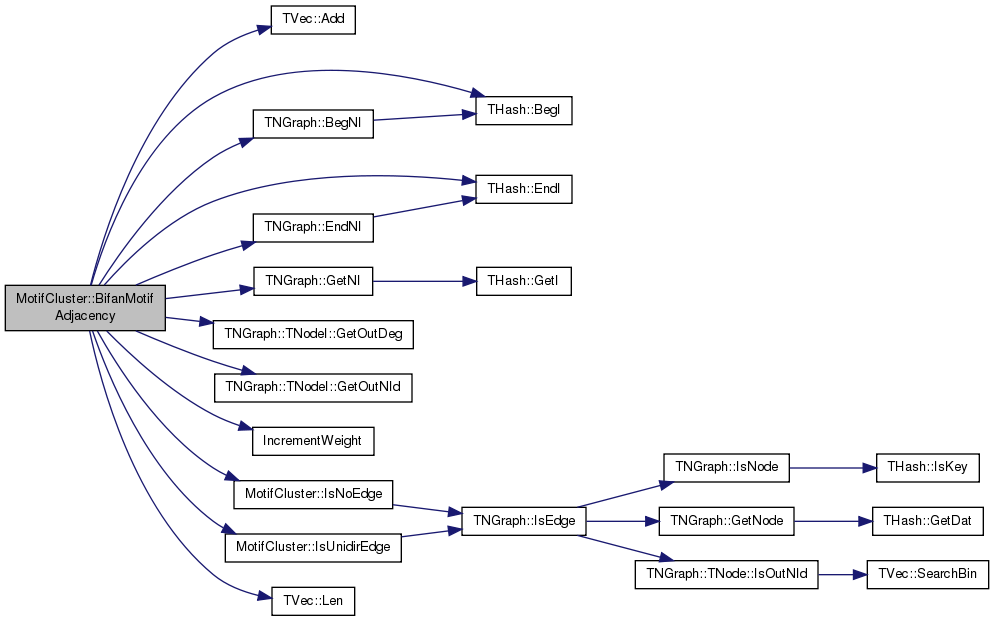

|
staticprivate |
Definition at line 503 of file motifcluster.cpp.
References ChibaNishizekiWeighter::Run(), and ChibaNishizekiWeighter::weights().
Referenced by MotifAdjacency().
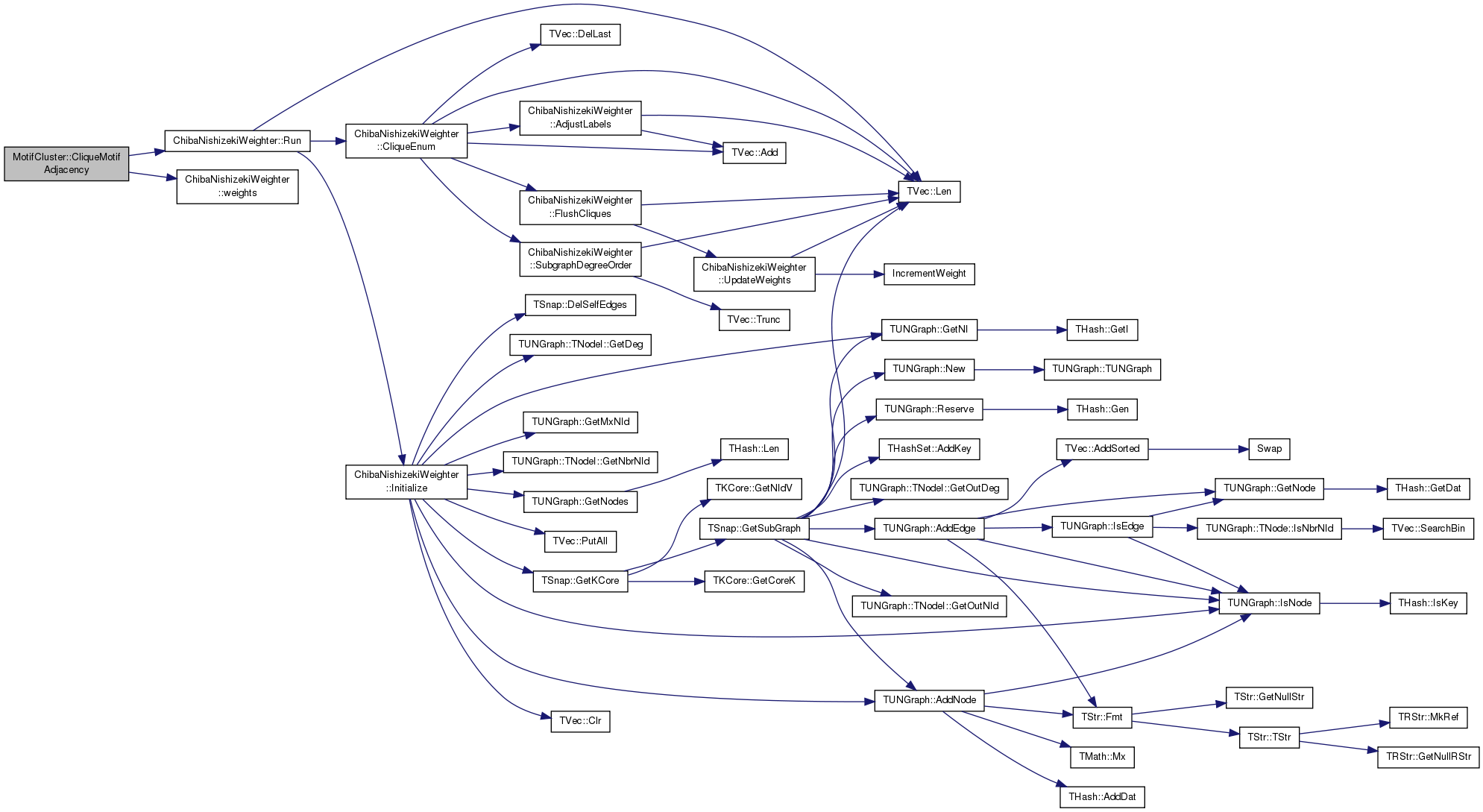

Definition at line 185 of file motifcluster.cpp.
References TNGraph::BegNI(), TNGraph::EndNI(), TNGraph::GetMxNId(), TVec< TVal, TSizeTy >::Len(), TVec< TVal, TSizeTy >::PutAll(), and TVec< TVal, TSizeTy >::Sort().
Referenced by TriangleMotifAdjacency().
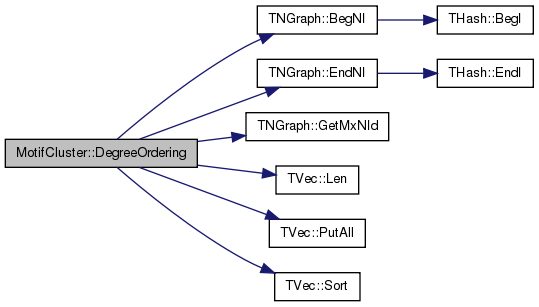

Definition at line 443 of file motifcluster.cpp.
References TNGraph::BegEI(), TNGraph::EndEI(), IncrementWeight(), and TNGraph::IsEdge().
Referenced by MotifAdjacency().
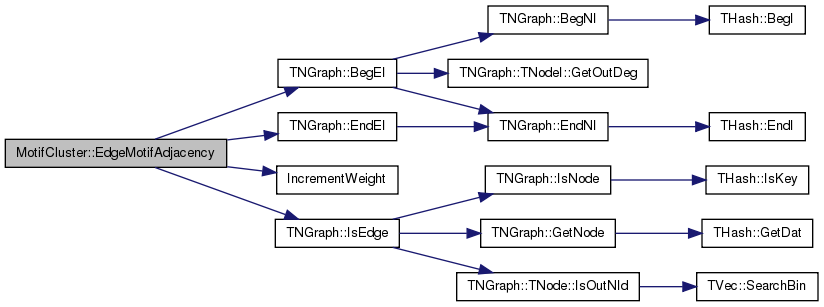

Definition at line 457 of file motifcluster.cpp.
References TUNGraph::BegEI(), TUNGraph::EndEI(), and IncrementWeight().
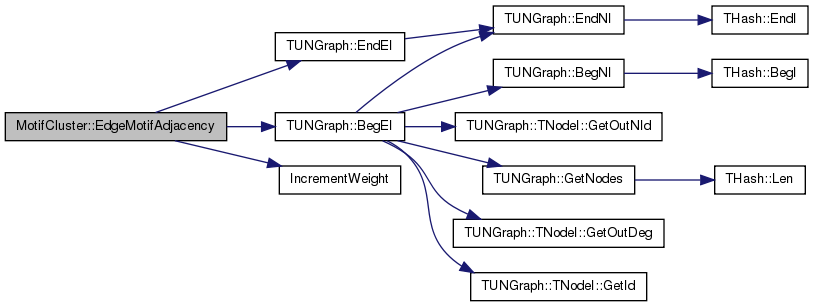
|
static |
Definition at line 701 of file motifcluster.cpp.
References MotifAdjacency(), and SpectralCut().
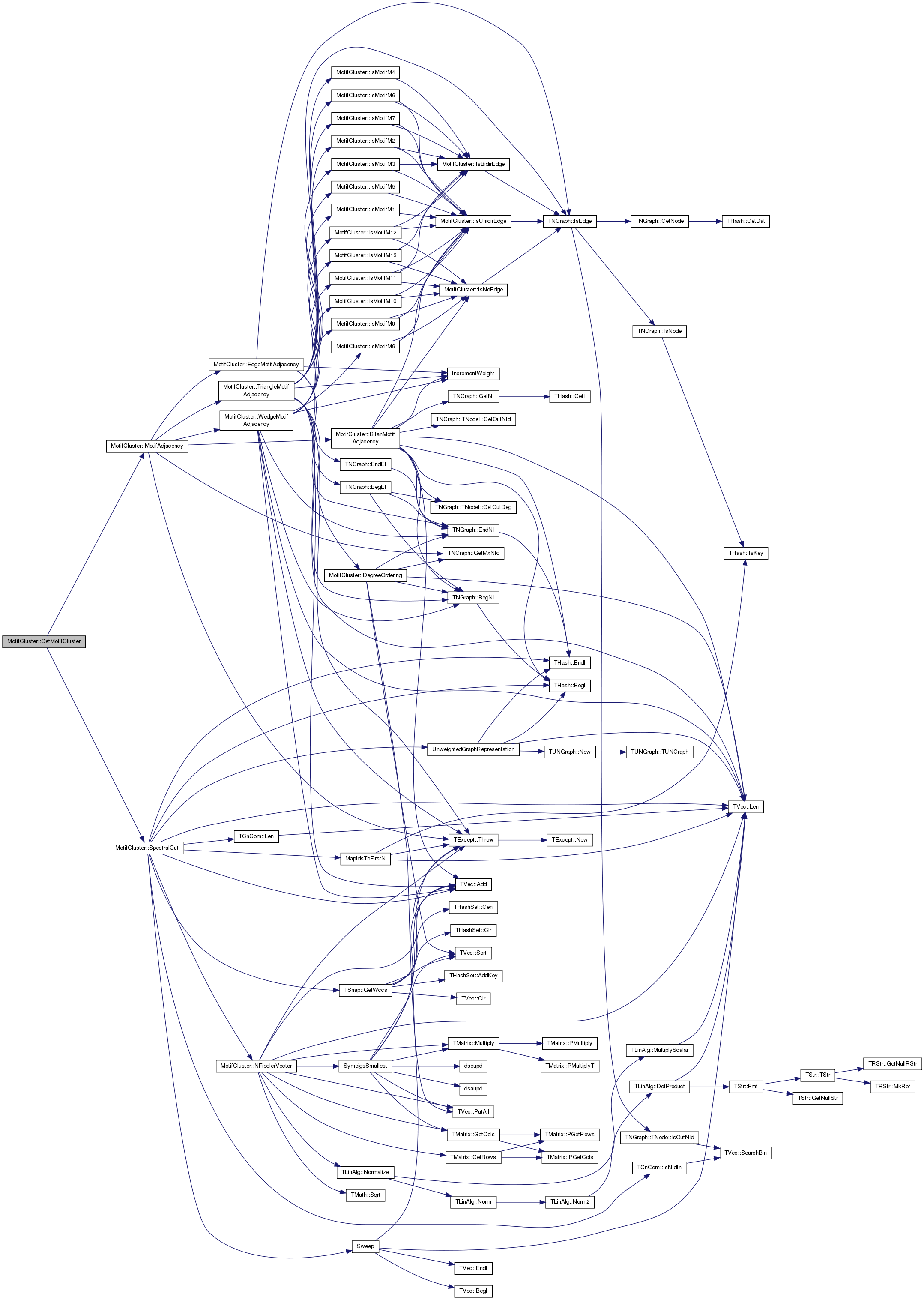
|
static |
Definition at line 709 of file motifcluster.cpp.
References MotifAdjacency(), and SpectralCut().
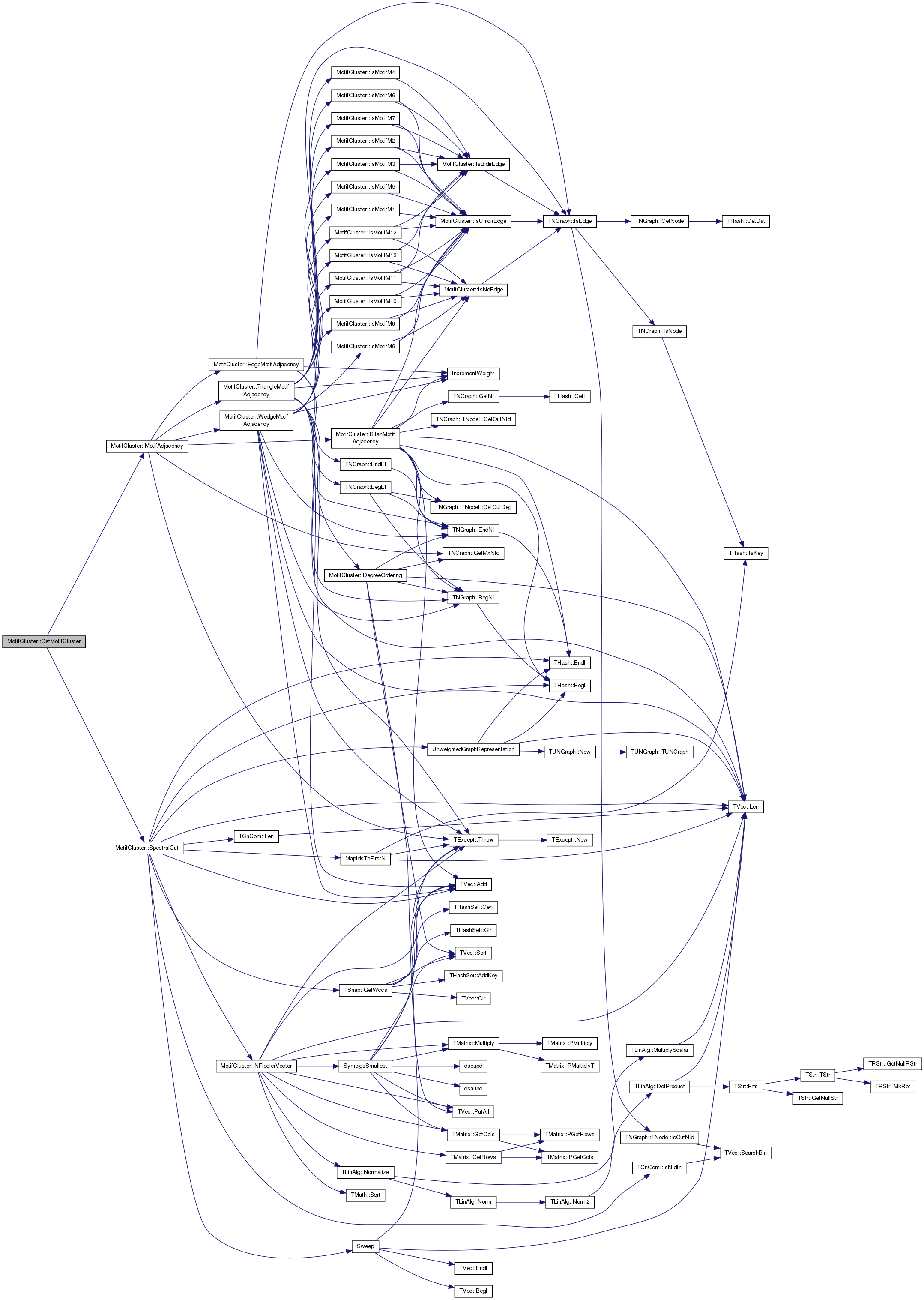
|
static |
Definition at line 80 of file motifcluster.cpp.
References TNGraph::IsEdge().
Referenced by IsMotifM11(), IsMotifM12(), IsMotifM13(), IsMotifM2(), IsMotifM3(), IsMotifM4(), IsMotifM6(), and IsMotifM7().

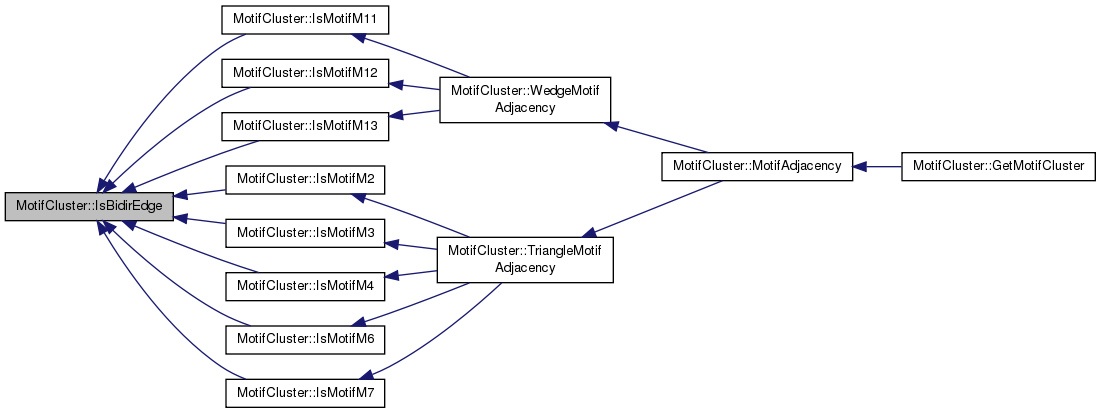
|
static |
Definition at line 84 of file motifcluster.cpp.
References IsUnidirEdge().
Referenced by TriangleMotifAdjacency().


|
static |
Definition at line 160 of file motifcluster.cpp.
References IsNoEdge(), and IsUnidirEdge().
Referenced by WedgeMotifAdjacency().


|
static |
Definition at line 165 of file motifcluster.cpp.
References IsBidirEdge(), IsNoEdge(), and IsUnidirEdge().
Referenced by WedgeMotifAdjacency().


|
static |
Definition at line 171 of file motifcluster.cpp.
References IsBidirEdge(), IsNoEdge(), and IsUnidirEdge().
Referenced by WedgeMotifAdjacency().


|
static |
Definition at line 177 of file motifcluster.cpp.
References IsBidirEdge(), and IsNoEdge().
Referenced by WedgeMotifAdjacency().


|
static |
Definition at line 91 of file motifcluster.cpp.
References IsBidirEdge(), and IsUnidirEdge().
Referenced by TriangleMotifAdjacency().


|
static |
Definition at line 106 of file motifcluster.cpp.
References IsBidirEdge(), and IsUnidirEdge().
Referenced by TriangleMotifAdjacency().


|
static |
Definition at line 116 of file motifcluster.cpp.
References IsBidirEdge().
Referenced by TriangleMotifAdjacency().


|
static |
Definition at line 121 of file motifcluster.cpp.
References IsUnidirEdge().
Referenced by TriangleMotifAdjacency().


|
static |
Definition at line 131 of file motifcluster.cpp.
References IsBidirEdge(), and IsUnidirEdge().
Referenced by TriangleMotifAdjacency().


|
static |
Definition at line 140 of file motifcluster.cpp.
References IsBidirEdge(), and IsUnidirEdge().
Referenced by TriangleMotifAdjacency().


|
static |
Definition at line 149 of file motifcluster.cpp.
References IsNoEdge(), and IsUnidirEdge().
Referenced by WedgeMotifAdjacency().


|
static |
Definition at line 154 of file motifcluster.cpp.
References IsNoEdge(), and IsUnidirEdge().
Referenced by WedgeMotifAdjacency().


|
static |
Definition at line 72 of file motifcluster.cpp.
References TNGraph::IsEdge().
Referenced by BifanMotifAdjacency(), IsMotifM10(), IsMotifM11(), IsMotifM12(), IsMotifM13(), IsMotifM8(), and IsMotifM9().


|
static |
Definition at line 76 of file motifcluster.cpp.
References TNGraph::IsEdge().
Referenced by BifanMotifAdjacency(), IsMotifM1(), IsMotifM10(), IsMotifM11(), IsMotifM12(), IsMotifM2(), IsMotifM3(), IsMotifM5(), IsMotifM6(), IsMotifM7(), IsMotifM8(), and IsMotifM9().

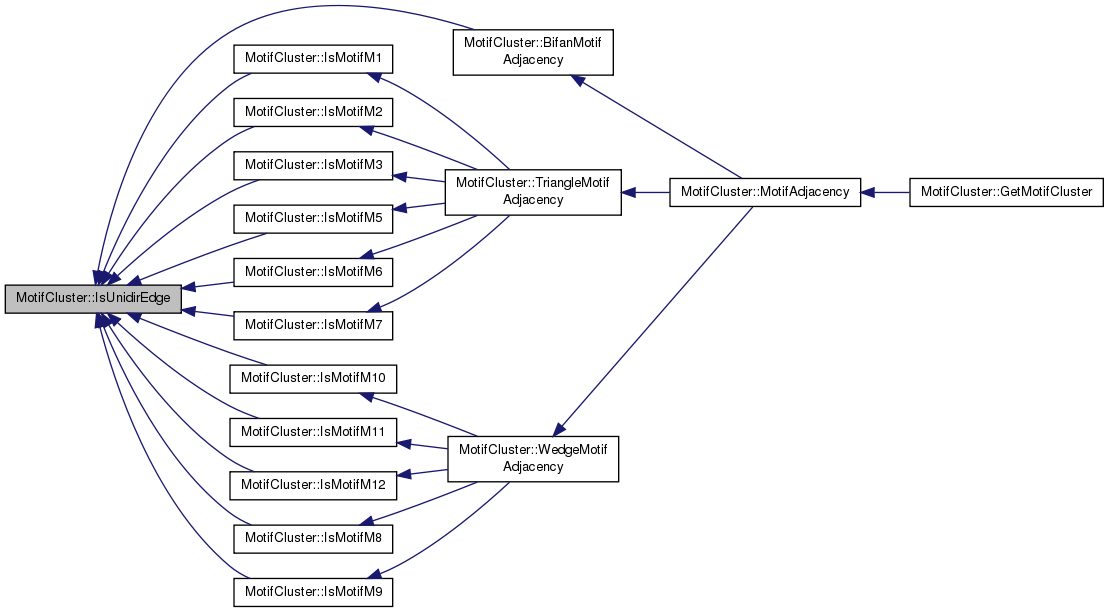
Definition at line 471 of file motifcluster.cpp.
References bifan, BifanMotifAdjacency(), edge, EdgeMotifAdjacency(), TNGraph::GetMxNId(), M1, M10, M11, M12, M13, M2, M3, M4, M5, M6, M7, M8, M9, TExcept::Throw(), TriangleMotifAdjacency(), and WedgeMotifAdjacency().
Referenced by GetMotifCluster().
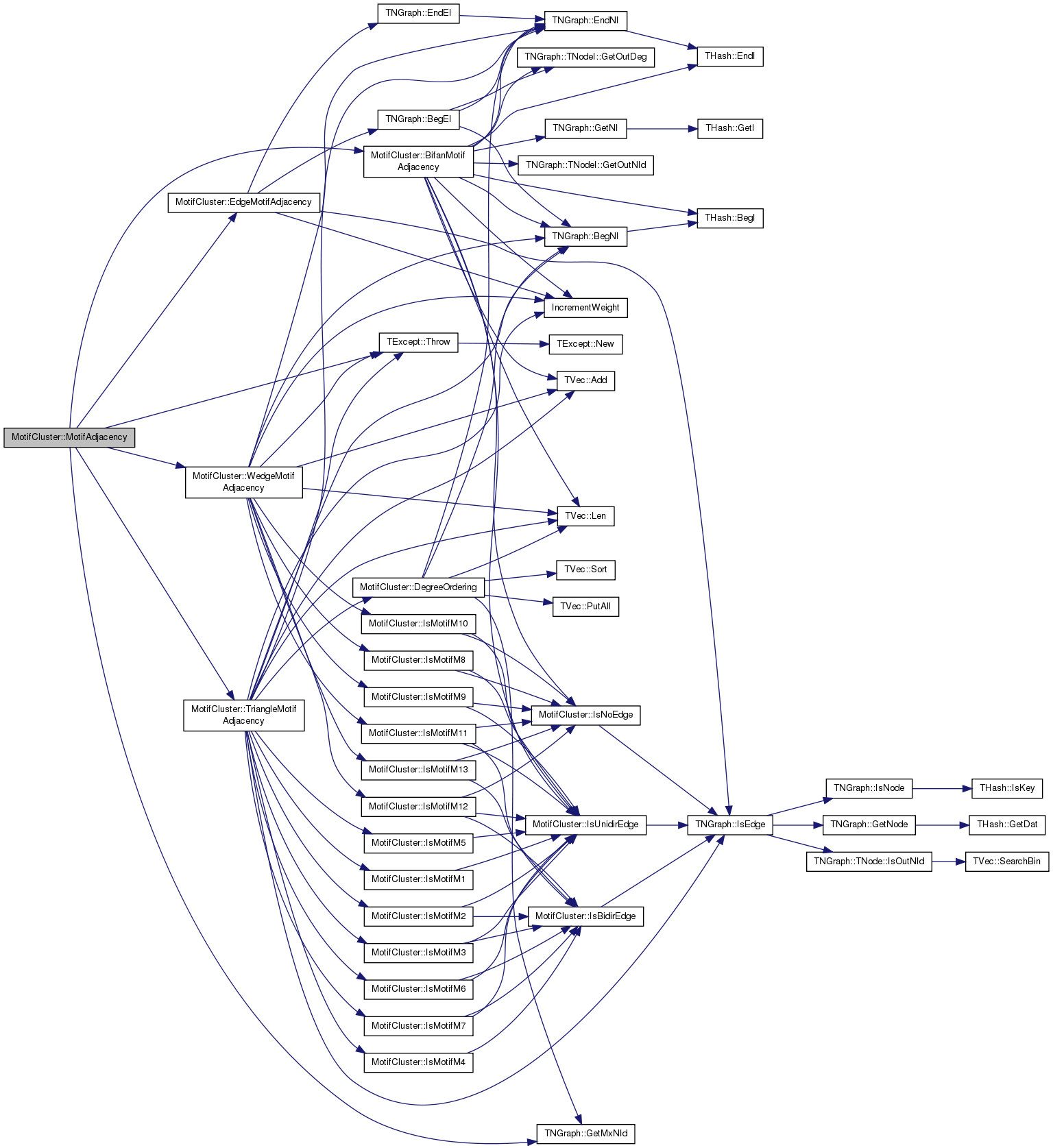

Definition at line 510 of file motifcluster.cpp.
References clique3, clique4, clique5, clique6, clique7, clique8, clique9, CliqueMotifAdjacency(), edge, EdgeMotifAdjacency(), TUNGraph::GetMxNId(), semiclique, SemicliqueMotifAdjacency(), TExcept::Throw(), and triangle.
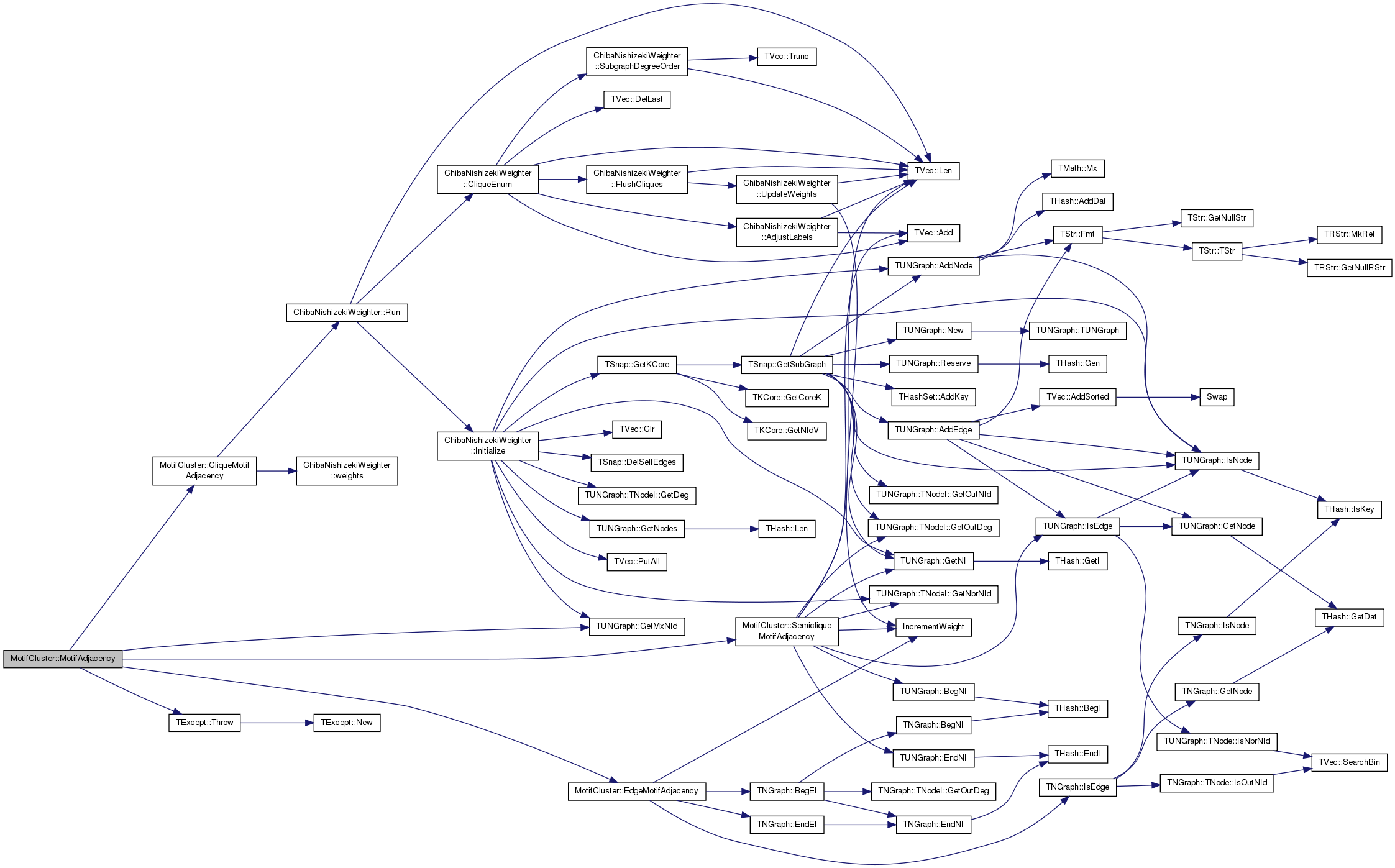
|
static |
Definition at line 717 of file motifcluster.cpp.
References TVec< TVal, TSizeTy >::Add(), TSparseColMatrix::ColSpVV, TFullColMatrix::ColV, TMatrix::GetCols(), TMatrix::GetRows(), TVec< TVal, TSizeTy >::Len(), TMatrix::Multiply(), TLinAlg::Normalize(), TVec< TVal, TSizeTy >::PutAll(), TMath::Sqrt(), SymeigsSmallest(), and TExcept::Throw().
Referenced by SpectralCut().
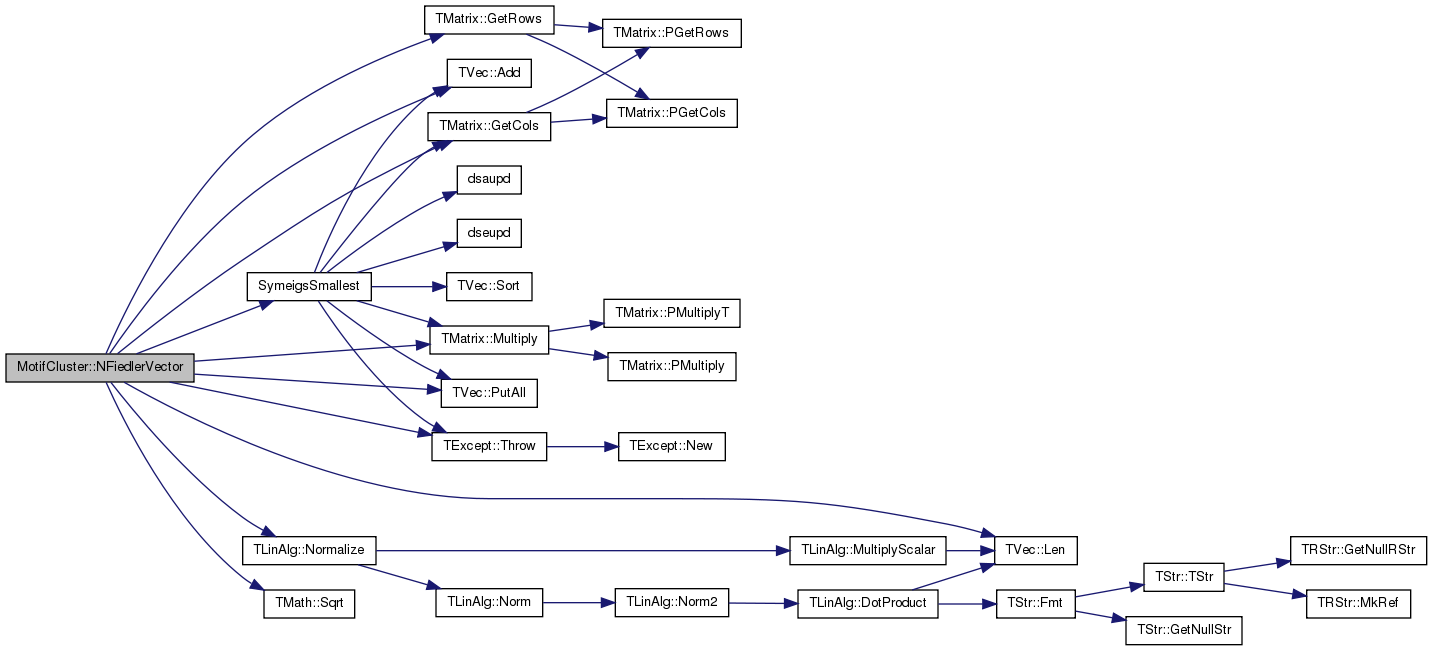

Definition at line 36 of file motifcluster.cpp.
References bifan, clique3, clique4, clique5, clique6, clique7, clique8, clique9, edge, TStr::GetLc(), M1, M10, M11, M12, M13, M2, M3, M4, M5, M6, M7, M8, M9, semiclique, TExcept::Throw(), and triangle.

Definition at line 405 of file motifcluster.cpp.
References TVec< TVal, TSizeTy >::Add(), TUNGraph::BegNI(), TUNGraph::EndNI(), TUNGraph::TNodeI::GetNbrNId(), TUNGraph::GetNI(), TUNGraph::TNodeI::GetOutDeg(), IncrementWeight(), TUNGraph::IsEdge(), and TVec< TVal, TSizeTy >::Len().
Referenced by MotifAdjacency().
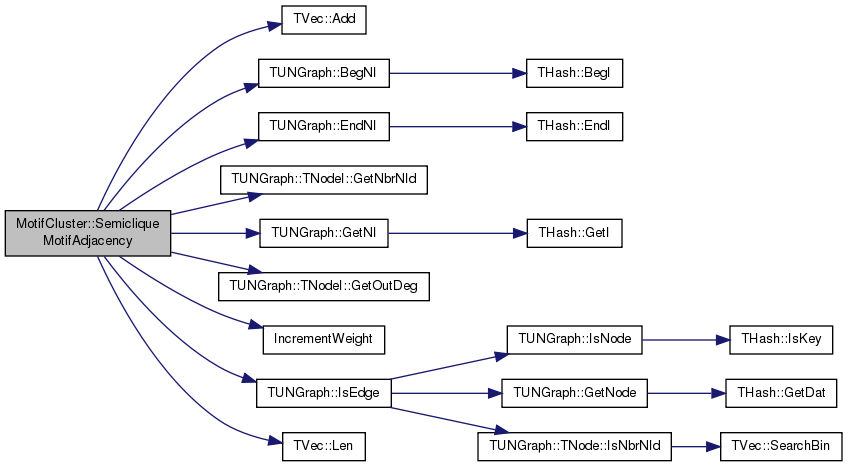

|
static |
Definition at line 871 of file motifcluster.cpp.
References TVec< TVal, TSizeTy >::Add(), THash< TKey, TDat, THashFunc >::BegI(), TSweepCut::cluster, TSweepCut::component, TSweepCut::cond, TSweepCut::eig, THash< TKey, TDat, THashFunc >::EndI(), TSnap::GetWccs(), TCnCom::IsNIdIn(), TCnCom::Len(), TVec< TVal, TSizeTy >::Len(), MapIdsToFirstN(), NFiedlerVector(), TCnCom::NIdV, Sweep(), TSweepCut::sweep_profile, and UnweightedGraphRepresentation().
Referenced by GetMotifCluster().
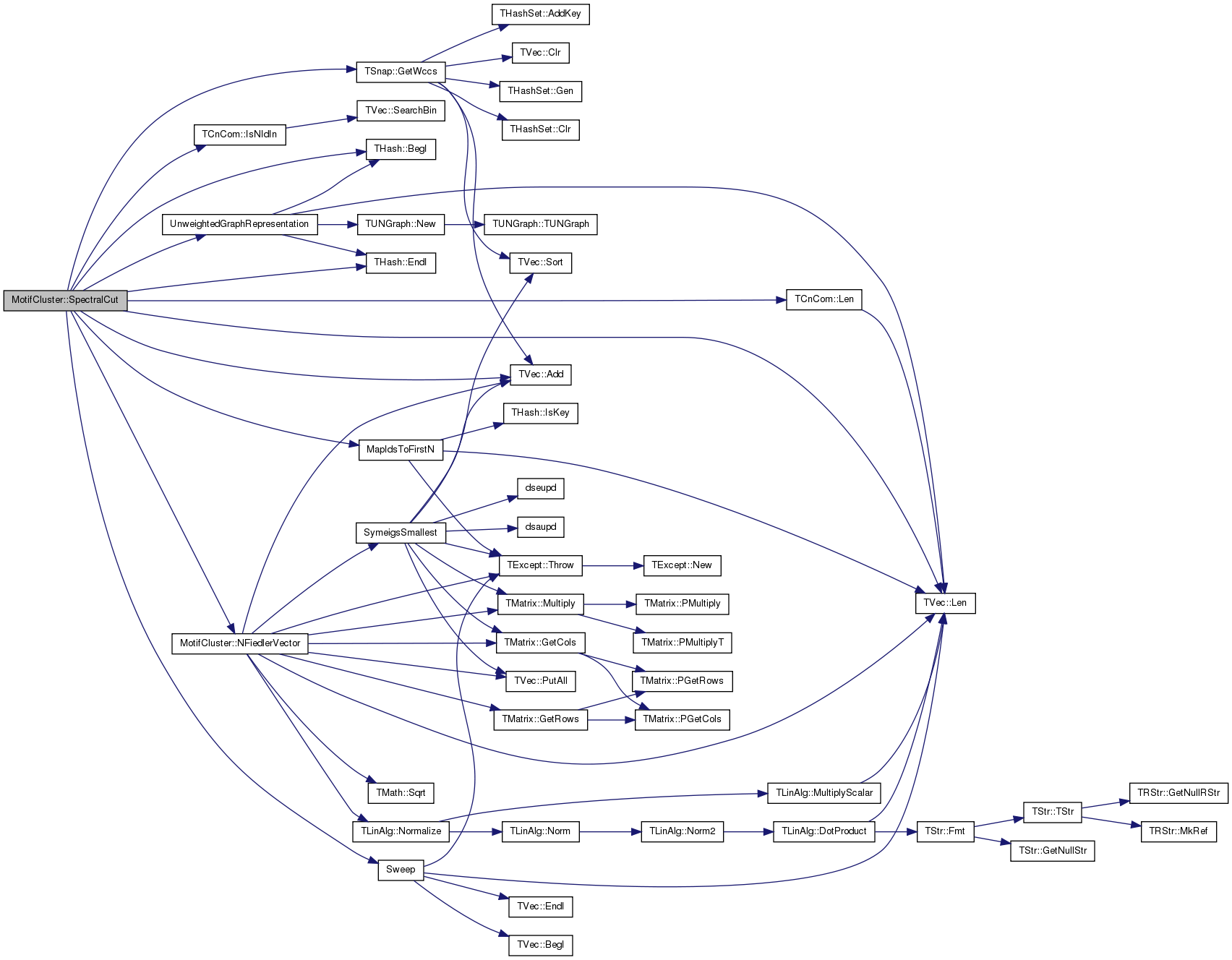

|
staticprivate |
Definition at line 213 of file motifcluster.cpp.
References TVec< TVal, TSizeTy >::Add(), TNGraph::BegNI(), DegreeOrdering(), TNGraph::EndNI(), IncrementWeight(), TNGraph::IsEdge(), IsMotifM1(), IsMotifM2(), IsMotifM3(), IsMotifM4(), IsMotifM5(), IsMotifM6(), IsMotifM7(), TVec< TVal, TSizeTy >::Len(), M1, M2, M3, M4, M5, M6, M7, and TExcept::Throw().
Referenced by MotifAdjacency().
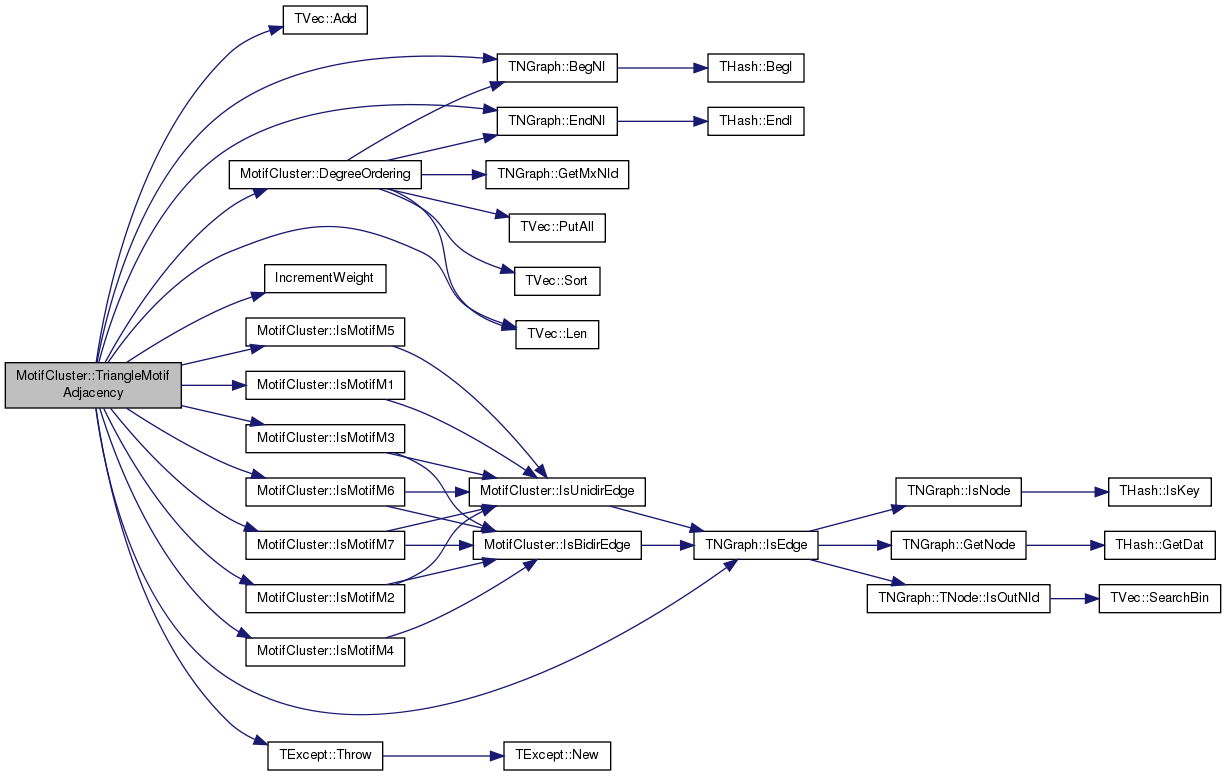

|
staticprivate |
Definition at line 282 of file motifcluster.cpp.
References TVec< TVal, TSizeTy >::Add(), TNGraph::BegNI(), TNGraph::EndNI(), IncrementWeight(), IsMotifM10(), IsMotifM11(), IsMotifM12(), IsMotifM13(), IsMotifM8(), IsMotifM9(), TVec< TVal, TSizeTy >::Len(), M10, M11, M12, M13, M8, M9, and TExcept::Throw().
Referenced by MotifAdjacency().
